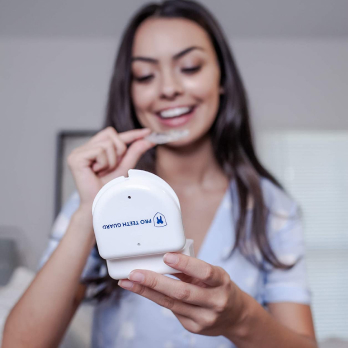Bruxism Surgery
19th Dec 2021

The idea of bruxism surgery may seem strange. After all, people grit their teeth in frustration all the time. How much damage can teeth grinding really cause? Turns out, quite a lot. A sleeping person's bite strength can exert up to 250 pounds of pressure, according to the Sleep Foundation. That's enough to do some serious damage, so it's no wonder that the symptoms of untreated bruxism can progress rapidly from jaw pain, facial pain, earaches, and sore jaw muscles to more serious concerns like temporomandibular joint disorders.
There are many less aggressive options for bruxism treatment and bruxism surgery is typically a last resort for only severe cases. Restorative surgeries may be suggested when dental issues are particularly advanced. In a similar fashion, jaw surgery may be recommended for severe TMJ disorders. What do you need to know about bruxism and surgery for bruxsim?

Can Jaw Surgery Cure Bruxism?
Typically, surgery is a way to correct damage suffered as a result of teeth grinding and jaw clenching. However, surgery is not usually a form of “treatment” for bruxism. In some extreme cases, surgery can be used for those suffering from TMJ to correct a misaligned jaw or injured jaw joint. Additionally, if a patient is grinding their teeth as a response to misaligned teeth, crowns, inlays, or prostheses can be used to correct bite alignment.
Do I Need Surgery for Bruxism?
Surgery is sometimes used to fix the damage caused by teeth grinding and clenching. As Johns Hopkins Medicine reports, bruxing doesn't just cause pain. It can also cause some serious damage to your teeth and jaw muscles:
- Chipped, cracked, or missing teeth.
- Eroded tooth enamel that exposes the inner surfaces of teeth.
- Popping or clicking of the TMJ.
- Locking of the jaw.
- Dislocation of the jaw.
When bruxism causes extensive tooth wear or tooth loss, surgery for bruxism may be the only way to restore both form and function to your smile. If the repetitive teeth grinding has damaged one or both jaw joints, you may be dealing with a TMJ disorder. If so, surgery is generally the last resort, but it might be recommended in particularly progressed cases.
Related Articles:

Types of Surgery to Correct Bruxism Damage
The type of surgery that might be needed to correct bruxism damage varies. It depends on the specifics of your oral health situation, your overall health, and the damage itself.
For teeth damage, there are several restorative procedures that a dentist or oral surgeon can use to fix your smile. Over time, the erosion of the protective enamel leaves teeth incredibly vulnerable. Chips and cracks can lead to broken teeth. They can also become vulnerable to bad bacteria. This can lead to the development of cavities and infections. When simple fillings aren't enough, more involved procedures may be needed:
- Root Canal: During a root canal, the dentist removes the inflamed or diseased pulp from inside the tooth. After a careful cleaning, they fill and seal the remaining tooth. It's a way to restore form and function to a badly damaged tooth. However, many teeth that undergo root canals will be topped with crowns.
- Crown: A crown is a cap that is fashioned to resemble a tooth. It's placed on top of a damaged tooth or dental implant. It can be used to restore both appearance and function. Crowns can be crafted from porcelain, metal alloys, or other materials.
- Dental Implants: If teeth grinding has caused you to lose teeth, dental implants provide a solution. An oral surgeon inserts posts in your gums. Once these heal, crowns can be placed on the posts in areas where single teeth are missing. When multiple teeth are missing in the same area, bridges that hold multiple crowns may be used.
Health care providers generally begin with noninvasive treatments for TMJ disorders. However, if surgical intervention is required, a number of treatments are available:
- TMJ Arthroscopy: With a TMJ arthroscopy, an arthroscope is inserted into the joint via a tube, and small instruments are used for the procedure.
- Modified Condylotomy: A modified condylotomy is an indirect treatment. The procedure is done on the mandible (lower jaw bone), rather than the TMJ.
- Open-joint Surgery: When there are structural problems with the TMJ, open-joint surgery may be needed to repair it.
- Oral And Maxillofacial Surgeries: Oral and maxillofacial surgeons specialize in treating injuries and defects in the functional and aesthetic features of the face and mouth. With constant advances, there may be new oral and maxillofacial surgeries that fit your needs.

How to Avoid Bruxism Surgery
The best way to avoid bruxism surgery is to manage your bruxism effectively, before it progresses. Treating teeth grinding is made easier when you can identify the cause of bruxism. Fortunately, you have several great tools for treatment. Mayo Clinic offers some helpful hints:
- Night Guards: Mouthguards and occlusal splints (in the case of TMJ) are devices worn over either the upper or lower teeth. They help you avoid damage from grinding by keeping your teeth from making contact with each other.
- Treatment Of Other Disorders: Other medical conditions can trigger bruxism; treating them may help resolve your bruxism. If it's a side effect of a medication, changing the medication may help. If it's an underlying medical condition like acid reflux, sleep apnea, or other sleep disorders, treating the issue may stop the bruxing.
- Botox: Injections of Botox into the cheek or jaw muscles can ease the persistent clenching and grinding.
- Muscle Relaxers: Sometimes, short courses of muscle relaxers are prescribed to temporarily relieve pressure.
- Physical Therapy: Practicing the optimal positions for your jaw and mouth can help break bruxing behaviors.
- Stress Management: Stress is strongly associated with bruxism. Learning to manage stress can help treat the disorder. Meditation, exercise, and meeting with a therapist are popular strategies.
Related Articles:
Bruxism Surgery
When left unchecked, the repetitive teeth grinding and jaw clenching involved in bruxism can be destructive. In severe cases, surgery may be the best way to repair the damage. Fortunately, being proactive about managing the symptoms of bruxism can protect your teeth and jaws. With proper bruxism treatment, you're less likely to suffer the kind of painful damage that needs bruxism surgery.
Many dentists recommend wearing a night guard to protect your smile. At Pro Teeth Guard, you can get a custom-fit mouthguard at an affordable price. We make our night guards in a professional dental lab, and every night guard is guaranteed to fit comfortably with our 110% money-back guarantee.
References:
- AAE Writing Staff. (2021). What is a root canal? American Association of Endodontists. https://www.aae.org/patients/root-canal-treatment/what-is-a-root-canal/
- Booth, D. F., & Diplacido, F. P. (n.d.). What is Oral & Maxillofacial surgery? Oral Surgery Albuquerque. https://www.omsanewmexico.com/patient-information/what-is-oral-maxillofacial-surgery/
- Johns Hopkins Writing Staff. (n.d.). Bruxism. Johns Hopkins Medicine. https://www.hopkinsmedicine.org/health/conditions-and-diseases/bruxism
- Mayo Clinic Staff. (2017). Bruxism (teeth grinding). Mayo Clinic. https://www.mayoclinic.org/diseases-conditions/bruxism/diagnosis-treatment/drc-20356100
- Mayo Clinic Staff. (2018). TMJ disorders. Mayo Clinic. https://www.mayoclinic.org/diseases-conditions/tmj/diagnosis-treatment/drc-20350945
- Mouth Healthy Writing Staff. (n.d.). Implants. Mouth Healthy. https://www.mouthhealthy.org/en/az-topics/i/implants
- Truong, K. T. (2021). Bruxism: Teeth grinding at night. Sleep Foundation. https://www.sleepfoundation.org/bruxism
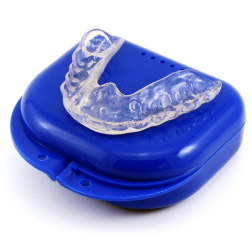
- Most Popular
- Hard Outside, Soft Inside
- 2MM Thick
- Moderate / Heavy
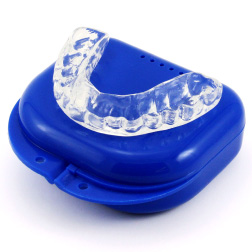
- Most Durable
- Hard Materials
- 1.5MM Thick
- Heavy / Severe
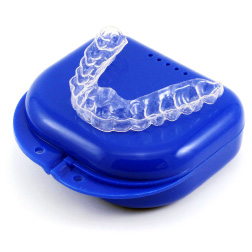
- For Day Time Use
- Thin, Barely Visible
- 1MM Thick
- Light / Moderate
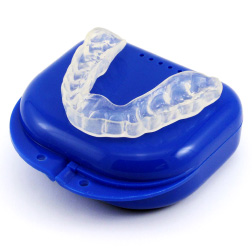
- For Clenching
- Flexible & Soft
- 1.5MM Thick
- Light / Moderate

